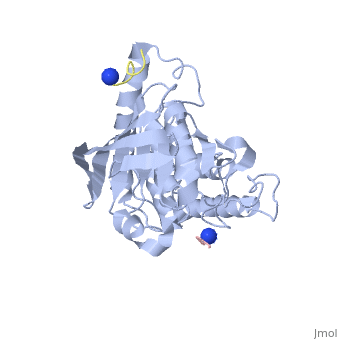1xxv
From Proteopedia
(New page: 200px<br /><applet load="1xxv" size="450" color="white" frame="true" align="right" spinBox="true" caption="1xxv, resolution 2.5Å" /> '''Yersinia YopH (residu...) |
|||
| Line 1: | Line 1: | ||
| - | [[Image:1xxv.gif|left|200px]]<br /><applet load="1xxv" size=" | + | [[Image:1xxv.gif|left|200px]]<br /><applet load="1xxv" size="350" color="white" frame="true" align="right" spinBox="true" |
caption="1xxv, resolution 2.5Å" /> | caption="1xxv, resolution 2.5Å" /> | ||
'''Yersinia YopH (residues 163-468) binds phosphonodifluoromethyl-Phe containing hexapeptide at two sites'''<br /> | '''Yersinia YopH (residues 163-468) binds phosphonodifluoromethyl-Phe containing hexapeptide at two sites'''<br /> | ||
==Overview== | ==Overview== | ||
| - | YopH is a protein tyrosine phosphatase and an essential virulence | + | YopH is a protein tyrosine phosphatase and an essential virulence determinant of the pathogenic bacterium Yersinia. Yersinia delivers YopH into infected host cells using a type III secretion mechanism. YopH dephosphorylates several focal adhesion proteins including p130Cas in human epithelial cells, resulting in disruption of focal adhesions and cell detachment from the extracellular matrix. How the C-terminal protein tyrosine phosphatase domain of YopH targets specific substrates such as p130Cas in the complex milieu of the host cell has not been fully elucidated. An N-terminal non-catalytic domain of YopH binds p130Cas in a phosphotyrosine-dependent manner and functions as a novel substrate-targeting site. The structure of the YopH protein tyrosine phosphatase domain bound to a model phosphopeptide substrate was solved and the resulting structure revealed a second substrate-targeting site ('site 2') within the catalytic domain. Site 2 binds to p130Cas in a phosphotyrosine-dependent manner, and co-operates with the N-terminal domain ('site 1') to promote efficient recognition of p130Cas by YopH in epithelial cells. The identification of two substrate-targeting sites in YopH that co-operate to promote epithelial cell detachment and bacterial virulence reinforces the importance of protein-protein interactions for determining protein tyrosine phosphatase specificity in vivo, and highlights the sophisticated nature of microbial pathogenicity factors. |
==About this Structure== | ==About this Structure== | ||
| - | 1XXV is a [http://en.wikipedia.org/wiki/Single_protein Single protein] structure of sequence from [http://en.wikipedia.org/wiki/Yersinia_enterocolitica Yersinia enterocolitica]. Active as [http://en.wikipedia.org/wiki/Protein-tyrosine-phosphatase Protein-tyrosine-phosphatase], with EC number [http://www.brenda-enzymes.info/php/result_flat.php4?ecno=3.1.3.48 3.1.3.48] Full crystallographic information is available from [http:// | + | 1XXV is a [http://en.wikipedia.org/wiki/Single_protein Single protein] structure of sequence from [http://en.wikipedia.org/wiki/Yersinia_enterocolitica Yersinia enterocolitica]. Active as [http://en.wikipedia.org/wiki/Protein-tyrosine-phosphatase Protein-tyrosine-phosphatase], with EC number [http://www.brenda-enzymes.info/php/result_flat.php4?ecno=3.1.3.48 3.1.3.48] Full crystallographic information is available from [http://oca.weizmann.ac.il/oca-bin/ocashort?id=1XXV OCA]. |
==Reference== | ==Reference== | ||
| Line 14: | Line 14: | ||
[[Category: Single protein]] | [[Category: Single protein]] | ||
[[Category: Yersinia enterocolitica]] | [[Category: Yersinia enterocolitica]] | ||
| - | [[Category: Bliska, J | + | [[Category: Bliska, J B.]] |
| - | [[Category: Ivanov, M | + | [[Category: Ivanov, M I.]] |
| - | [[Category: Saper, M | + | [[Category: Saper, M A.]] |
| - | [[Category: Schubert, H | + | [[Category: Schubert, H L.]] |
| - | [[Category: Stuckey, J | + | [[Category: Stuckey, J A.]] |
[[Category: catalytic domain]] | [[Category: catalytic domain]] | ||
[[Category: phosphotyrosine-binding sites]] | [[Category: phosphotyrosine-binding sites]] | ||
[[Category: substrate targeting]] | [[Category: substrate targeting]] | ||
| - | ''Page seeded by [http:// | + | ''Page seeded by [http://oca.weizmann.ac.il/oca OCA ] on Thu Feb 21 15:59:46 2008'' |
Revision as of 13:59, 21 February 2008
|
Yersinia YopH (residues 163-468) binds phosphonodifluoromethyl-Phe containing hexapeptide at two sites
Overview
YopH is a protein tyrosine phosphatase and an essential virulence determinant of the pathogenic bacterium Yersinia. Yersinia delivers YopH into infected host cells using a type III secretion mechanism. YopH dephosphorylates several focal adhesion proteins including p130Cas in human epithelial cells, resulting in disruption of focal adhesions and cell detachment from the extracellular matrix. How the C-terminal protein tyrosine phosphatase domain of YopH targets specific substrates such as p130Cas in the complex milieu of the host cell has not been fully elucidated. An N-terminal non-catalytic domain of YopH binds p130Cas in a phosphotyrosine-dependent manner and functions as a novel substrate-targeting site. The structure of the YopH protein tyrosine phosphatase domain bound to a model phosphopeptide substrate was solved and the resulting structure revealed a second substrate-targeting site ('site 2') within the catalytic domain. Site 2 binds to p130Cas in a phosphotyrosine-dependent manner, and co-operates with the N-terminal domain ('site 1') to promote efficient recognition of p130Cas by YopH in epithelial cells. The identification of two substrate-targeting sites in YopH that co-operate to promote epithelial cell detachment and bacterial virulence reinforces the importance of protein-protein interactions for determining protein tyrosine phosphatase specificity in vivo, and highlights the sophisticated nature of microbial pathogenicity factors.
About this Structure
1XXV is a Single protein structure of sequence from Yersinia enterocolitica. Active as Protein-tyrosine-phosphatase, with EC number 3.1.3.48 Full crystallographic information is available from OCA.
Reference
Two substrate-targeting sites in the Yersinia protein tyrosine phosphatase co-operate to promote bacterial virulence., Ivanov MI, Stuckey JA, Schubert HL, Saper MA, Bliska JB, Mol Microbiol. 2005 Mar;55(5):1346-56. PMID:15720545
Page seeded by OCA on Thu Feb 21 15:59:46 2008

